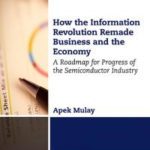Originally published in EBN http://www.ebnonline.com/author.asp?section_id=3315&doc_id=275093&
The US semiconductor Industry has undergone a transformation from a few Integrated Device Manufacturers (IDMs) to several Fabless businesses. When author Daniel Nenni asked me to write a review for his book Fabless: The Transformation of the Semiconductor Industry, I agreed eagerly. In that review, I mentioned that the US economy needs major reforms towards a free market economy.
In a recent article published on Semiwiki titled “Intel CEO misinformed on the foundry business,” the discussion revealed that the author of the article prefers fabless business model over the IDM model. He considers the IDM model to be a centrally planned model due to centrally planned design and manufacturing operations. One comment on the blog equated the IDM model to the economic theory of Communism because of central planning, and hence considered it to be a failure given the collapse of Soviet Communism.
As a macroeconomist of microelectronics business, I have a solid grasp on the concepts of macroeconomics. In my upcoming book Mass Capitalism : A Blueprint for Economic Revival, I have offered concrete solutions for the progress of Moore’s law as well as transition to 450 mm silicon wafers through true free market reforms in global semiconductor industry. I want to help industry professionals (mostly scientists, bloggers, and engineers) understand economics, as well as point out common misconceptions. Before we analyze what Semiwiki bloggers had to say about IDM model and why they think present fabless-foundry model is better than IDM, let us understand some basic concepts of economics.
In one of my blogs “Are Crony Capitalism and Communism two sides of the same coin ?”, I said, “Communism centralizes production and other economic functions through state-controlled industries, rather than through private ownership. Thus in case of Communism, control of the economy lays in the hands of a few government officials.” From the point of view of centralizing the design and manufacturing, Semiwiki bloggers are correct in equating the IDM model to Communism because of centralized design and manufacturing operations.
However, they are misinformed in considering the present fabless-foundry business model as a free market economic model. Let me explain. In the same blog, I said:
Capitalism in the US has been transformed from a free market enterprise of 1950s to a crony monopoly enterprise system in its search for producing commodities at lowest cost and for selling them at a highest price. To produce commodities cheaply, US based MNCs followed a centralized supply chain to achieve efficient transportation, cheap raw materials, cheap labor, cheap energy, adequate water supply, etc. This kind of centralized supply chain has distorted US manufacturing supply chain.
The fabless-foundry model is certainly superior to the IDM model because it ushers in co-operative collaboration between the fabless businesses and foundries. It has also resulted in growth of several small fabless businesses. However, today major fabless players have offshored their manufacturing operations to foundries in Asia.
As a result of free trade policies, fabless-foundry model is increasing US trade deficits due to centralized supply chains of fabless companies. Additionally, a few Wall Street stockholders have reaped huge profits from offshoring of manufacturing to Asia. This has translated to a sharp decline of semiconductor manufacturing in the US. High unemployment due to decline in manufacturing has forced US government to pay for unemployment benefits of laid off workers. This transformation of US semiconductor industry from IDMs to foundry-fabless players has been a major contributor to US twin (trade and budget) deficits. The monetary policies followed by Federal government to sustain these deficits have resulted in frequent intervention of democratically elected governments into the economy to reduce unemployment.
A true free market economy is an economy where the intervention of government into the economy is minimal. Additionally, in a true free market economy, the real job creators are not only the producers but also the consumers. In fact, jobs are created in a free market economy by means of a co-operative action between the producers and the consumers. Such a free market economy has smaller size of government and hence even taxes are low on all individuals. Crony Capitalism is form of capitalism where the government intervention into the economy is high and government follows policies, which result in creation of corporate monopolies by creating a legal framework for monopolies to thrive. Crony capitalism in contrast to free market Capitalism also results in accumulation of unsustainable deficits against consumer interests and national interest.
That being so, if Semiwiki bloggers equate IDM model to Communism, then the present fabless-foundry business model could be equated to crony Capitalism due to US macroeconomic policies. In order to ensure that there are true free markets in the US economy, the centralized supply chains, which are followed by fabless companies, should undergo decentralization, which would also increase their efficiency. By ensuring decentralization of supply chains, the present fabless-foundry business model can usher in a true free market economy.


Recent Comments